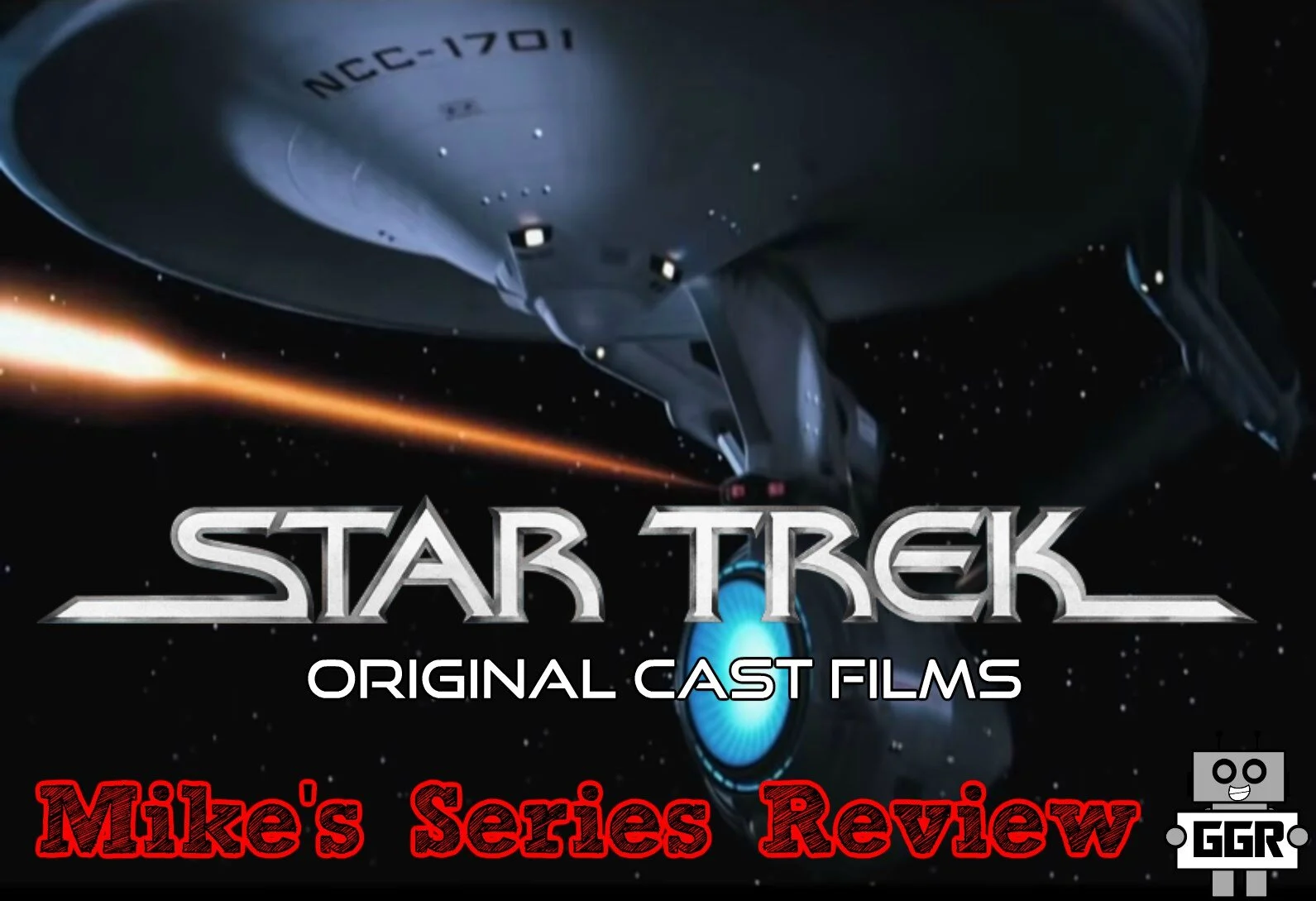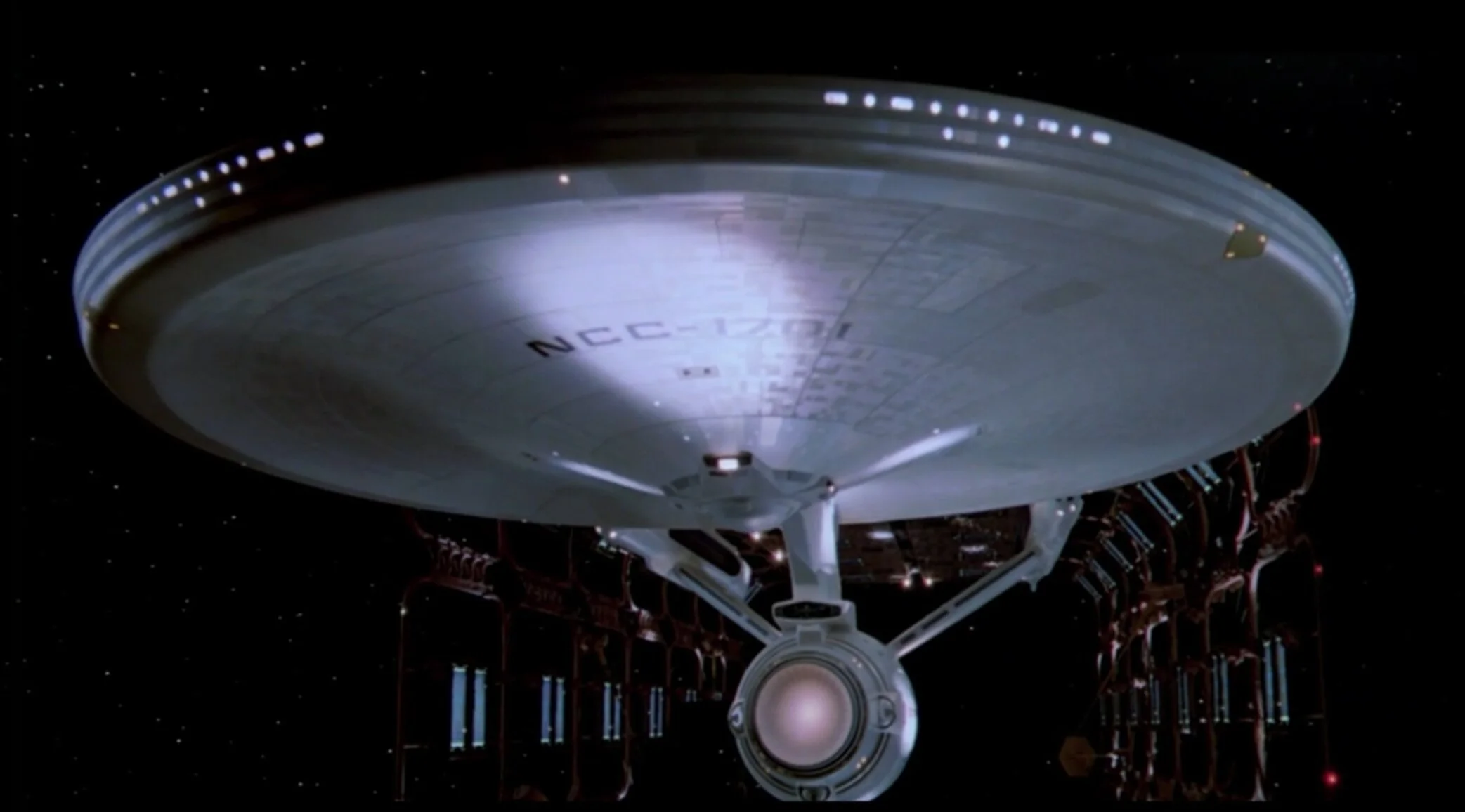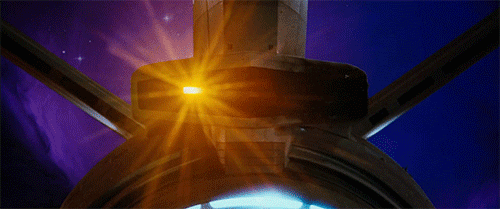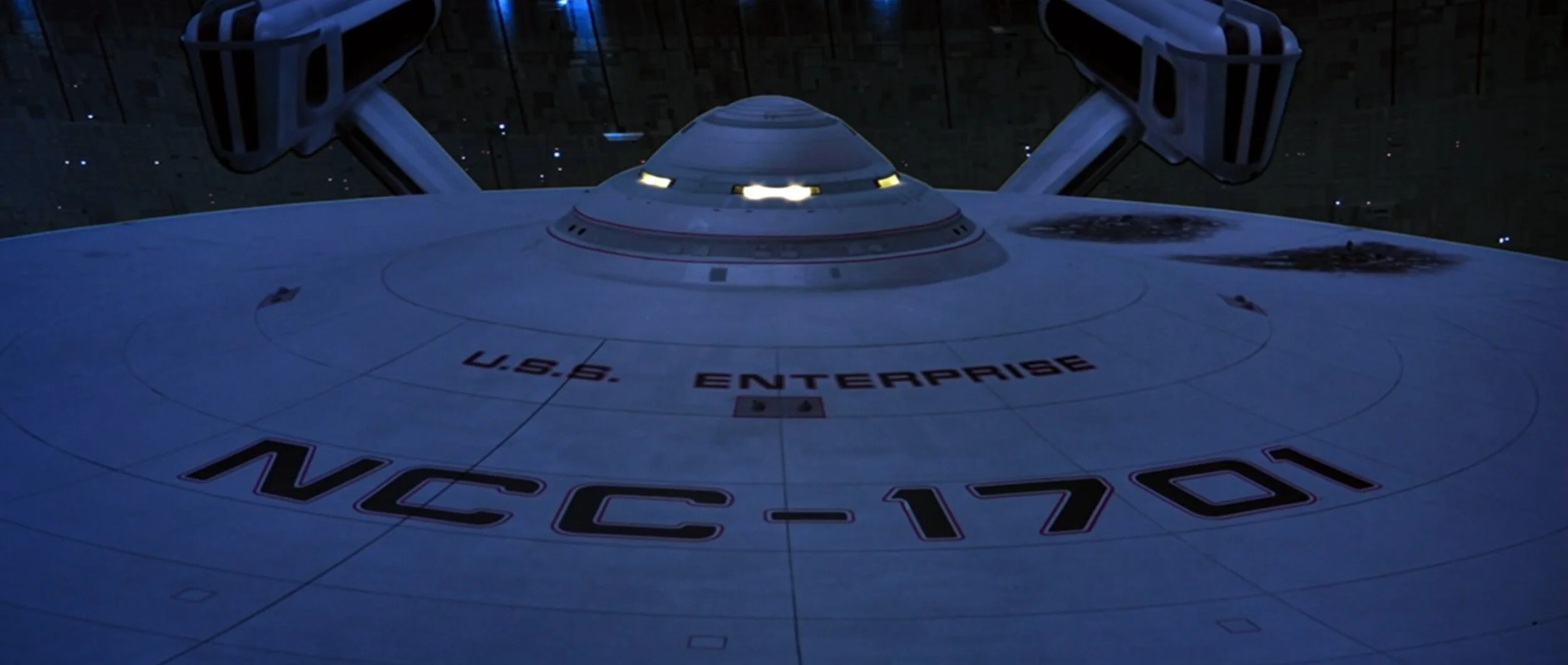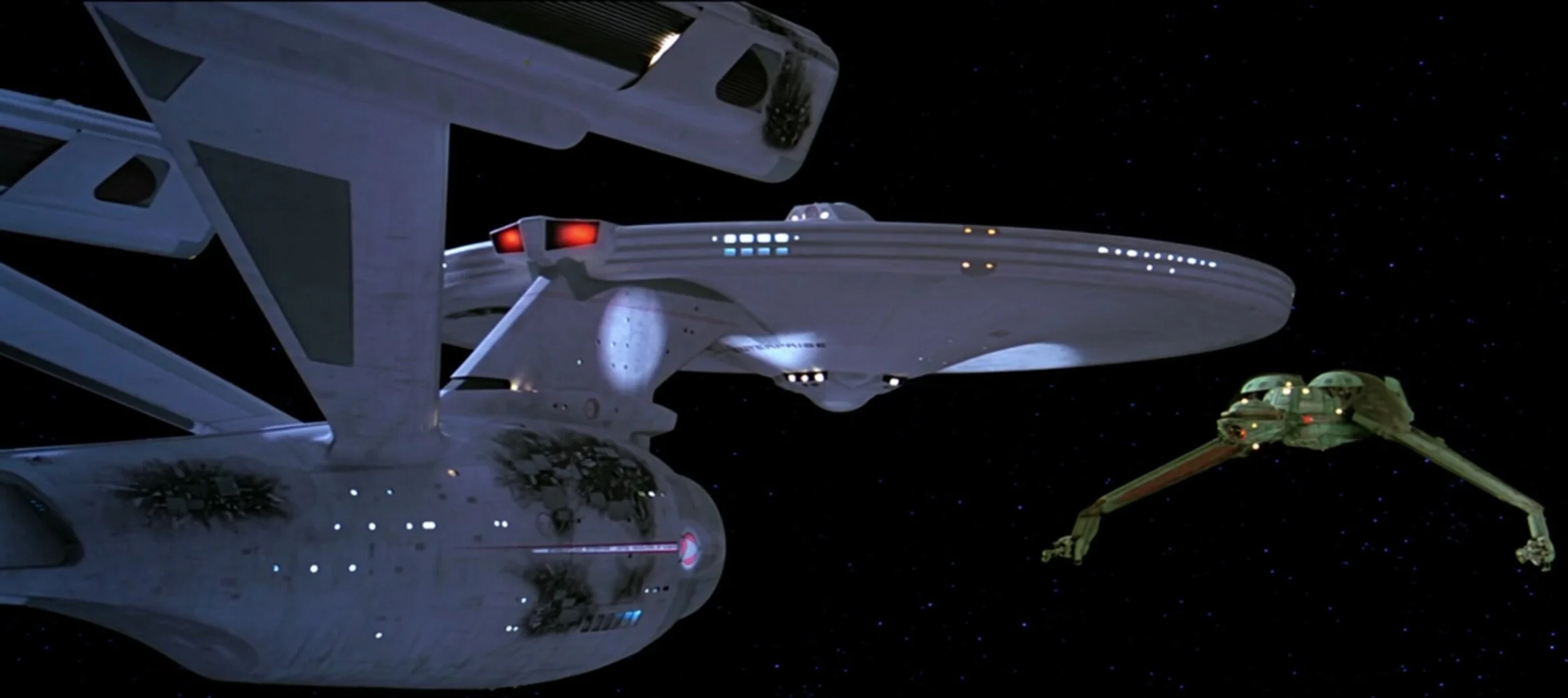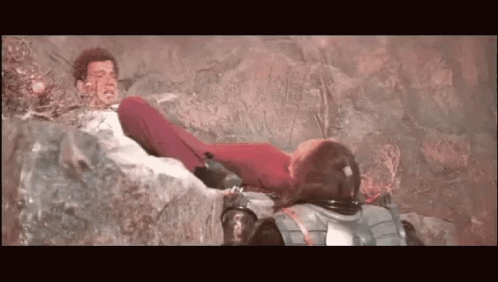Mike's Series Review: Star Trek - Original Cast Films Part 1
by Mike Lunsford, Editor-In-Chief
Space, the final frontier. These are the continuing voyages of the Starship Enterprise. Her ongoing mission, to explore strange new worlds, to seek out new lifeforms and new civilizations. To boldly go where no man has gone before.
Who hasn’t heard some version of that introduction? It’s been around since 1966 when Captain James T. Kirk and his crew took the Enterprise on her first 5 year mission. Star Trek in its many different incarnations is one of the most well known franchises on the planet. Everyone has their favorite series. The older generation (if you’re over 50, I’m talking about you) loves the original series. The millennials, they love Next Generation or Deep Space Nine. For the in-between-ers like myself (they call me a Xennial, half Gen X half Millennial), we’re all over the map. Some of us love the Next Generation series, but me…I’m an original cast person. Don’t get me wrong, I love TNG, too but the original crew are still my favorites. In particular, the original cast movies is my “series." Those movies were my introduction to Star Trek. I remember being in Kindergarten and watching Star Trek III: The Search for Spock on ABC’s Tuesday Night Movie of the Week. I wore that recorded-from-TV Betamax cassette out. That started my love of that series. That and my dad getting us a copy of Wrath of Khan and letting me rent The Motion Picture from whatever the 80’s equivalent to Blockbuster was at the time…I think it was called Erol’s. ANYWAY, let’s get to talking about those original Star Trek movies!
What makes the original cast Star Trek film franchise so notable, other than a few films that became some of the best science fiction movies of all time, was how the crew of the Enterprise was able to continue their “ongoing mission.” Star Trek was only on the air from 1966 to 1969. It struggled with ratings during its 3 year run and network executives never really liked the show. When it was cancelled, Paramount Studios tried to recoup their production losses by selling its syndication rights. By the late 1970s, Star Trek had been sold in over 150 domestic and 60 international markets and had developed a world-wide cult following. Rumors of a revival started and by 1979, there was the first ever Star Trek film on the big screen! One of the most successful film franchises of all time was on its way, speeding through the galaxy. Let’s begin with the movie that started it all as we review the first 3 movies in the film franchise.
Star Trek: The Motion Picture
After an extended drydock stay to update the U.S.S. Enterprise, the heroic ship is called back into service when a mysterious and immensely powerful alien cloud known as V'Ger approaches Earth, destroying everything in its path. The since-promoted Admiral James T. Kirk assumes command of his former vessel to lead it on a mission to save the planet and determine V'Ger's origins. However, there were complications abound as the Federation’s flagship and her crew try to work out all the kinks of their entirely new systems and equipment before they can intercept this dangerous entity. The warp drive doesn’t work properly, their new science officer becomes a puddle of goo after a transporter malfunction and Admiral Kirk has no idea how this new ship works! Plus, he has to contend with the former captain-now-first-officer Will Decker’s anger and frustration at his demotion. What will the Enterprise crew do to come together and stop this freaky-looking cloud thing with the dope synth sound effects before it makes it to Earth?
What was cool about Star Trek: The Motion Picture was the entire original crew returned to star in the movie. It was 10 years since they had last been to the 23rd century, but they were able to bring back all of the main players. The most dramatic return was that of Leonard Nimoy as Spock, both in the film and in real life. Nimoy was not happy with being typecast as the pointy-eared, logical Vulcan science officer. He even wrote a book titled I Am Not Spock. It turns out the title was deceiving, Nimoy immensely enjoyed the role, but fans thought based on the title that he did not. He was a huge part of The Motion Picture as Spock comes aboard the Enterprise at the perfect time. He takes the role of science officer and helps Scotty realign the warp engines so they can intercept V’Ger.
Chekov, Scotty, Spock, Nurse Chapel, Janice Rand, Doctor McCoy, Uhura, Sulu, and Captain Kirk! And they’re all in pajamas!
When all is said and done with Star Trek: The Motion Picture, it’s a long movie that has a ton of scenes of the crew staring at the view screen with a concerned look on their faces. I’m sure director Robert Wise had a fun time repeating over and over to the actors “look confused and slightly angry…and action!”
It’s an interesting story and fascinating concept, though. 40+ year spoiler alert here, but V’Ger is revealed to be a 20th century NASA space probe named Voyager 6 that was thought lost to a black hole. It found itself on the other side of the galaxy where it crashed landed on a planet of sentient machines that took Voyager’s rudimentary programming of “learn all that is learnable and return that knowledge to the creator” very literally. Voyager 6 had amassed so much knowledge, it had become sentient. The machine planet inhabitants wanted to help their little buddy, so they built V’Ger a super dope cloud/ship to carry it back to Earth and gave it some really cool upgrades, like the ability to vaporize matter and convert it to data.
The story itself is not horrible, it’s actually a cool sci-fi concept. However, the movie DRAGS. The uniforms they chose for the crew of the Enterprise look like leisure wear instead of the uniform of a military organization. What was the shining jewel for Star Trek: The Motion Picture was the newly refit U.S.S. Enterprise. The new ship was gorgeous. Long time fans were elated to see the Enterprise on the big screen and on top of that, it had a sleek new look!
Still my favorite version of the Enterprise
Star Trek: The Motion Picture was a financial success, grossing $139 million worldwide however Paramount was not happy with it’s cost ($46 million just for creation of the film, not including marketing costs and expectations) and thought that Gene Roddenberry’s involvement was a chief reason for the movies poor critical reception. Needless to say, the money made was enough to green light a sequel, but there would be changes. Paramount was insistent that it be considerably cheaper. Normally, with those sorts of restraints, it spells disaster. However, when it came to The Motion Picture’s sequel, the exact opposite happened.
Star Trek II: The Wrath of Khan
Set approximately 10-15 years after The Motion Picture, Admiral Kirk is back to his role of training the newest crop of command recruits for Starfleet. While inspecting his former ship, the Enterprise (now used solely as a training ship under the command of Captain Spock), Admiral Kirk receives a message from an old flame: Doctor Carol Marcus. She has a cryptic conversation with Kirk about “Genesis” that is cut short due to interference. After investigating what the Genesis Device is (a powerful terraforming matrix) the Enterprise races to space lab Regula 1, where Doctor Marcus, her and Kirk’s son David, and their staff were working on the device. They run into the USS Reliant, a research vessel that was working on the Genesis Project to find a suitable planet. However, unbeknownst to Admiral Kirk and crew, the Reliant was commandeered by the genetically engineered tyrant Khan Noonien Singh! Khan uses the Reliant to attack the Enterprise, crippling the ship and almost destroying it. He would have succeeded were it not for a clever plan from the Admiral. Kirk and crew must scramble to repair the ship and stop Khan’s plans of capturing the Genesis device for his nefarious plans. We all know the rest of this story.
Another old spoiler alert (this time 38 years), was easily one of the biggest moments of science fiction history: the death of Spock. Somehow during the production of the movie, the news got leaked that Spock would die in this movie. This was such a big deal, that fans took out ads in newspapers begging Paramount not to kill the character, even Entertainment Tonight did a poll about whether or not the Vulcan science officer should die. When the final film was released and Captain Spock “dies” in the Kobyashi Maru simulation and Admiral Kirk says “aren’t you dead?” this lead many fans to believe that this was what all the fuss was about. However, as the finale plays out and we see that Spock sacrifices himself to save the ship and all on board, the sleight of hand was gut-punchingly apparent.
There may be Star Trek movies that you like more, there may be movies that grossed more at the box office, but it is difficult to contest that this is the strongest of all of the films. From top to bottom, Wrath of Khan was fantastic. What made it so good was that it took a serialized 60s sci-fi staple and added depth. All the jokes about Kirk being a womanizer from the original series had a consequence: James T. Kirk had a son. A villain-of-the-week that we’re supposed to never think of again gets a chance to wreak some revenge.
The script was done by Jack B. Sowards and Nicholas Meyer, who also directed the film. They crafted a story that was really about the consequences of Kirk’s machismo as a young captain, both with a son he barely knows and leaving Khan and his crew on Seti Alpha V and never checking in on them. Ultimately, David’s hatred towards him and Khan’s thirst for vengeance are his fault; a product of his own oversight and desire to continue “galloping through the cosmos” as Carol Marcus said. It’s also about aging and having to come to grips with our own mortality. On top of the subtext of the movie, it’s also an awesome science fiction concept. If science can develop the means to turn a dead planet into one that supports life, what happens if someone uses it on a world that already has life? An incredible tool can be turned into a horrific weapon in the wrong hands.
On top of the amazing subtleties of the script and the concepts of science fiction that really make you think, the movie is action-packed. The space battle scenes are enthralling. The special effects team, while having a significantly smaller budget than it’s predecessor, manages to have some scenes that still hold up to this day. The effects are all practical and for me, make me miss this sort of addition to space dramas. The things that can be done with computers today are truly amazing, but I miss the giant models they would make for these films.
On top of the action, the acting is great as well. Shatner has some great scenes, Leonard Nimoy’s death scene is still a tear-jerker to this day. But, Ricardo Montalbán as Khan? Wow. Some call his performance cheesy, and it might be, but his it is definitely iconic.
and contrary to the rumors you’ve heard, that is his real chest, not a prosthetic.
Star Trek II: The Wrath of Khan quickly overshadowed its predecessor when it came to reviews. Interestingly enough, it never out-grossed The Motion Picture but it is still regarded today as one of the best Star Trek films of all time and ultimately had a higher profit margin as it was much cheaper to produce than the first film. It guaranteed that the film franchise would continue to be a profitable venture for Paramount and the storyline involving the Genesis planet would continue on with the third installment.
Star Trek III: The Search For Spock
The Enterprise is making her way back to Earth following the encounter with Khan, the creation of the Genesis planet, and the death of Spock. Admiral Kirk is still trying to cope with the death of his trusted comrade when Starfleet command informs him there will be no return trip to Genesis. The experiment has caused a fervor throughout the galaxy and the Federation has deemed it off limits to everyone except the science teams. If matters couldn’t get worse, Spock’s father, Sarek visits Kirk to determine why his son’s body was left on Genesis. The Vulcan way is to mind meld with someone they are close to before death so their “katra” can live on. They determine, through security footage from the Enterprise that Spock mind melded with Bones, which explains his current psychological issues. Kirk swears to Sarek that he will find a way to bring both Doctor McCoy and Spock’s body to Vulcan in an attempt to save Spock’s soul. However, a rogue Klingon commander is intent on using his Bird of Prey to steal any information about the Genesis device he can and find a way to steal the weapon for his own personal gain. Will Kirk be able to get the Enterprise back and recover Spock? Can he somehow be resurrected? What are the Klingons going to do and can Kirk stop them?
We can beat around the bush all we want, but everyone knows what happens: Spock comes back. A lot of times, when it comes to bringing back a dead character, it’s normally some eye-rollingly convoluted solution that brings back our hero. In the case of Star Trek, which tries to live by the concept of science fiction being something that COULD happen with advances in our current technology, Spock’s resurrection wasn’t unrealistic. First things first, he was on a planet that was created using terraforming technology that rearranges the molecules of dead matter and turns it into “a living, breathing planet.” It’s not unfathomable that this project could bring back a Vulcan who died of radiation poisoning. Star Trek III: The Search for Spock brings back the titular hero but like any good story, there are consequences for getting what you want.
As with Wrath of Khan, there was controversy surrounding the loss of a major character, however no one saw this loss coming. Kirk, Scotty, Dr. McCoy, Chekov and Sulu steal the Enterprise to retrieve their fallen comrade Spock from the Genesis planet. Unbeknownst to them, a Klingon Bird of Prey is cloaked and waiting for them, with Lieutenant Saavik, Kirk’s son David and a regenerated-by-the-Genesis-effect Spock being held hostage down on the surface of the planet. The Bird of Prey and Enterprise fight to a standstill but the Klingon commander leverages the hostages to make Kirk surrender the Enterprise, killing Kirk’s son to show him how serious he is. Kirk begrudgingly surrenders his ship but the wily Admiral has one trick left up his sleeve: the self-destruct option.
Seeing characters die was one thing, but the Enterprise? That was truly shocking. Its destruction killed the invading Klingon forces as Kirk and crew safely transported to the surface of the Genesis planet. As chronicled on our podcast, long-time Star Trek fan Ulysses E. Campbell has stated that seeing this scene play out after it being a threat in the original show was shocking to watch, but it is noted by many long time fans as one of the most shocking moments ever.
Kirk and crew escape to the Genesis planet and watch as the Enterprise burns up in the atmosphere. We get a great quote as they see their long-time vessel streak through the sky.
Kirk: My God, Bones, what have I done?
McCoy: What you had to do; what you always do: turn death into a fighting chance to live.
They gather themselves and manage to fight off the Klingons who still held Spock and Saavik captive. Kirk has a moment to grieve his son just before Commander Kruge (Christopher Lloyd, amazing in the role) beams to the planet to face Kirk. The rest of the Enterprise crew and Saavik beam aboard the Bird of Prey and we get some ol’ fashioned, original series Kirk-fist-fighting dudes action. Kirk and Kruge duke it out until we get to see the Admiral kick Doc Brown in the face repeatedly.
“I…have HAD…enough of YOU!”
Kirk beams up to the Bird of Prey with Spock’s unconscious body and they commandeer the Klingon vessel and speed off to Vulcan to resurrect their friend. After they arrive, Spock’s father Sarek thanks Kirk and the two sum up Kirk’s motives
Sarek : Kirk, I thank you. What you have done is...
Kirk : What I have done, I had to do.
Sarek : But at what cost? Your ship. Your son.
Kirk : If I hadn't tried, the cost would have been my soul.
Say what you will about the third film in comparison to Wrath of Khan but it embodies what these characters mean to each other. Not only did Kirk lose the Enterprise and his son David to save Spock, his career with Starfleet was in serious jeopardy as well. He risked everything to save his friend, or as he put it in the Captain’s log that opened the film, “the best part of himself.”
The film features moments that many Star Trek fans describe as their favorite throughout the entire series. When Admiral Kirk goes to Admiral Morrow, the Commander of Starfleet, to ask for permission to use the Enterprise to get Spock’s body and return it to Vulcan, the Admiral denies his request. Sulu and Chekov ask the Admiral how the meeting went, and he said “the word is no. I am therefore going anyway,” and it’s a roller coaster ride from there. The crew steal the Enterprise from Spacedock and have to contend with the new U.S.S. Excelsior, the test bed for trans-warp technology.
Kirk, Scotty, Sulu, Chekov and Bones race off to Genesis at warp speed as the Excelsior hits the button for trans-warp and….breaks down in front of Spacedock. Turns out Scotty sabotaged the trans-warp system before leaving their engineering section. Overall, it’s an exciting scene that is highlighted by James Horner’s amazing soundtrack, may he rest in peace.
On top of the amazing scene featuring the Excelsior, Star Trek II and Star Trek III also featured something never before seen in the franchise: different classes of Federation ships! We got to see the Miranda class ship with the Reliant in Wrath of Khan. When it came to Search for Spock we got 2 new ship classes and we got to see Spacedock for the first time! There was the Excelsior and the Oberth class U.S.S. Grissom that was studying the Genesis planet. It really expanded the breadth of Starfleet and the different ships that were used other than the Constitution class.
Star Trek III: The Search for Spock was the perfect end cap to the storyline that was established in Wrath of Khan. While Star Trek IV: The Voyage Home is the 3rd in the “Genesis trilogy,” it really is more like the pinnacle of the movie series. Voyage Home starts off tying up loose ends from II and III but ends up sending the crew in a completely different direction. Because it is the high point in the franchise, it will be the first film we talk about in part 2 of our Series Review of Star Trek - The Original Cast Films.
What began as an amazing story of resurrecting a 60s TV series and putting it on the silver screen turned into one of the most successful film franchises in movie history. It gave us iconic moments, legendary villains, some of the best science fiction movies of all time and brought Star Trek to a brand new generation of fans.
Stay tuned folks as I delve into part 2 soon. Until then, live long and prosper... and don’t be a juicebag.


